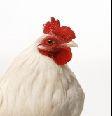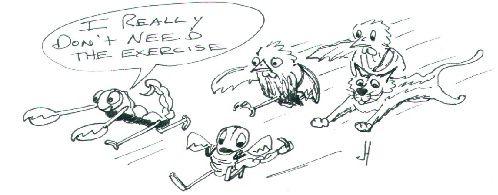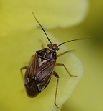Natural Solutions to Things That Bug You (76 page)
Read Natural Solutions to Things That Bug You Online
Authors: Myles Bader


HERE KITTY, KITTY
Cats are very effective in catching and removing scorpions, especially ones that do not like catching mice. We haven’t figured out the reasoning for this one yet.

LIGHT ‘EM UP
Scorpions tend to fluoresce under ultraviolet or black light and can easily be found at night. They are unable to jump and can easily be killed or captured. If you carry a hand vacuum with you, you can just vacuum them up and dispose of the bag.
BAIT THEM
A shallow plate with water and boric acid will work great at getting rid of them and their relatives.
Be sure that there are no pets or children around.
TRAP THEM
If you dampen an old burlap bag or any heavy piece of cloth and leave it on the ground at night, the scorpions will crawl under making it easy for you to find and kill them.
SILVERFISH
General Information:
 Silverfish do not have wings and are silvery to brown in color because their bodies are covered with fine scales. They are generally soft bodied and the adults can be up to ¾ inch long, flattened from top to bottom, elongated and oval in shape, have three long tail projections and two long antennae.
Silverfish do not have wings and are silvery to brown in color because their bodies are covered with fine scales. They are generally soft bodied and the adults can be up to ¾ inch long, flattened from top to bottom, elongated and oval in shape, have three long tail projections and two long antennae.
A relative of the silverfish is the firebrat, which is quite similar in habits but is generally darker in color. The firebrat prefers temperatures over 90
F but has a similar high humidity requirement. It is common near heating pipes, fire places, ovens and other heat sources.
Female silverfish lay eggs continuously after reaching the adult stage and may lie over 100 eggs during her life. Eggs are deposited singly or in small groups in cracks and crevices and hatch in 3 to weeks.
Silverfish develop from egg to adult within 4 to 6 weeks and continue to molt throughout their life. Immature stages appear similar to adults except they are about 1/20 of an inch long when they first hatch and generally whitish in color, taking on the adults’ silver coloring as they grow. They are long-lived, surviving from two to eight years.
Silverfish are chewing insects and general feeders but prefer carbohydrates and protein, including flour, dried meat, rolled oats, paper and even glue. They are capable of surviving long periods, sometimes over a year, without food but are sensitive to moisture and require a high humidity (75% to 90%) to survive.
 They also have a temperature preference between 70 and 80
They also have a temperature preference between 70 and 80
F. They move fast and are mostly active at night and generally prefer lower levels in homes, but may be found in attics. It is primarily a nuisance pest inside the home or buildings and can contaminate food, damage paper goods and stain clothing but is medically harmless. Many of their habits are similar to cockroaches and they appear to be more common as household pests in drier parts of the state. Occasionally they damage book bindings, curtains and even wallpaper.
These bugs have no odor and will not harm you. They also love to eat very young termites if there is a nest in the vicinity.
SETTING A STICKY TRAP
Take a piece of light cardboard and place some Tanglefoot™ on it, then place some oatmeal in the center. The Tanglefoot™ is very sticky and they can’t escape. They will never even make it to the oatmeal.
BE SWEET TO SILVERFISH
To get rid of silverfish, try mixing 1 part of molasses in 2 parts of white vinegar, then apply the mixture to any cracks or holes where they tend to reside. Make sure that you treat the baseboards and the table legs as well.
THEY LIKE HIGH HUMIDITY
If you keep the humidity low in the house with a dehumidifier chances are that you will never have to worry about silverfish.
You can also keep packets of silica gel around your bookshelf. These gel packets are available in most hardware stores.
PROTECT YOUR BOOKS
If you set out some of the herb santolina (lavender cotton) around your bookshelves it will repel silverfish. You can also sprinkle some diatomaceous earth (DE) around the books.
If you use DE be sure and wear a mask and eye protection.
THE GLASS TRAP WORKS GREAT
Use a jar and butter the inside 1-2 inches. Wrap the outside with masking tape and give them a tongue depressor ramp. Bait the trap with some wheat flour or sugar and in the morning it should be filled with silverfish. Pour soapy water in to drown them.
SYMPHYLAN
General Information:
 This bug is often confused with the centipede and is called the “garden centipede.” It is not a good bug to have in the garden.
This bug is often confused with the centipede and is called the “garden centipede.” It is not a good bug to have in the garden.
It has a body that is broken up into 14 segments and moves around on 12 pairs of legs.
They will eat young plant roots and are voracious eaters. To check to see if you have this pest doing damage, just dunk a root ball in a bucket of water and wait for the pest to rise to the top.
THEY DON’T CARRY FLOOD INSURANCE
If you have a field that is infested the best method is to flood the area and drown them. This is not a good method if all you have is a small garden.
INVITE THEM TO TEA
Preparing a tea with garlic and tobacco will do in the bugs in short order. Just drench the area to kill them.
Just drench the area to kill them.
TARNISHED PLANT BUG
General Information:
 These are brown and black bugs with nymphs that love to suck up plant juices. The areas on the affected plants will be a dark color. They lay their eggs on the leaves and will also feed on weeds and grass. They will hibernate in the winter in cracks or in trash.
These are brown and black bugs with nymphs that love to suck up plant juices. The areas on the affected plants will be a dark color. They lay their eggs on the leaves and will also feed on weeds and grass. They will hibernate in the winter in cracks or in trash.
TOUGH CRITTERS
There are no known good controls for these bugs. You can try the typical bug removal methods of picking them off and using Nc nematode mulch around the base of the plants. The soap and lime spray will irritate them and they may move on.
CHAPTER 14
